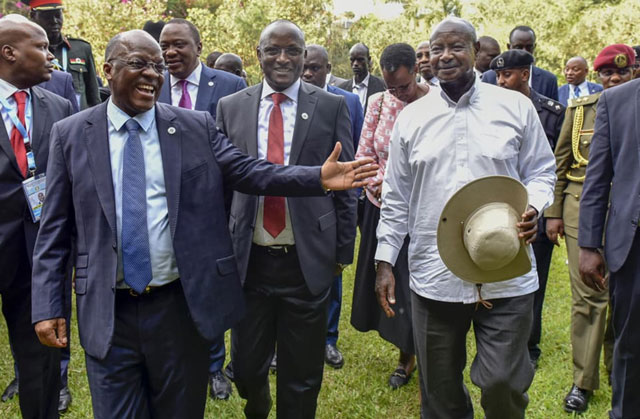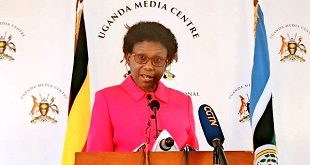
Kampala, Uganda | THE INDEPENDENT| Uganda’s President Yoweri Museveni has urged East African leaders to push for political integration in order to secure the future prosperity of the region.
“I am happy that the negotiators have agreed on the initial step of the confederation and on the framing of a draft Constitution for the Confederation,” Museveni said as he opened the 19th Ordinary East African Community Heads of State Summit at Speke Resort Munyonyo in Kampala.
He said that East Africa, unlike many regions in the world, has got enough similarities and areas of compatibility that should enable it to target political integration in the form of a political federation.
“We need to look at political integration where possible, where there are enough similarities or compatibilities. East Africa, unlike many regions in the World, has got enough similarities and compatibilities that can enable it to target political integration in the form of the Political Federation of East Africa,” Museveni said.
He mentioned the growing population in the region, a similar culture and shared natural resources as key unifying factors in East Africa.
“When, therefore, we talk about integration in East Africa, we have solid reasons on which we base ourselves. We are on the right side of history,” he concluded.
The Kampala summit received the Council of Ministers report for the period May 2017-Feb 2018, got a report on implementation of previous summit decisions and approved the appointment of Charles Nyachae of Kenya as Judge of the First Instance Division of the East African Court of Justice.
The leaders also launched the 5th East African Community Development Strategy to run until 2021.
Museveni however warned that economic integration alone,may not address the issue of strategic security well. Economic integration deals with trade. ” That is why we need to look at political integration where possible,” he said.
Presidents Uhuru Kenyatta of Kenya, John Pombe Magufuli of Tanzania and Salva Kiir Mayardit of South Sudan attended the summit. President Paul Kagame of Rwanda is being represented by the Minister of Infrastructure, James Musoni, while President Pierre Nkurunziza of Burundi is represented by the Vice-President Martin Nduwimana.
On Saturday, Museveni and Kenyatta cap the summit at the Uganda-Kenya border where they launch a one-stop border post that will reduce clearance time from half an hour, to a few mins.
*****
FULL SPEECH
PRESIDENT Yoweri Museveni’s SPEECH AT THE OPENING SESSION OF THE 19TH SUMMIT OF EAC HEADS OF STATE
Your Excellencies,
Ladies and gentlemen.
I welcome Your Excellencies, all the participants and friends to this 19th Summit of the EAC Heads of State. Both at the recent African Union Summit, last night at the Gala and yesterday during the Infrastructure Summit, it is most gratifying to notice the mood on the issue of integration. Integration in Africa, right from the beginning, was for the following reasons:
(a) Prosperity for our citizens through the bigger sales of goods and services on account of the bigger markets;
(b) Guaranteeing our strategic security against all the greedy eyes in the World that are tempted by our weakness on account of excessive political fragmentation;
(c) Ending the fragmentation (political, economic, cultural and social) of the culturally linked Peoples of Africa;
(d) And manage the shared natural resources (e.g. Lakes, Rivers etc.) better – in co-ordination;
- Going point by point, I am glad everybody is getting convinced that numbers matter alot in economics. Yesterday, President Kenyatta pointed out the fact that India has an advantageous starting point of 1.3bn consumers. Even then, India’s growth accelerated when it opened up in 1991. Prior to that time, the size of the Indian economy was US$ 278.4 billion. China’s economy in 1978, before their opening up, was US$ 153 billion, their consumer base of 1.3 billion people notwithstanding. Today, their economy is US$ 21.3 trillion. Therefore, numbers –local and foreign – matter alot when it comes to the creation of prosperity. East Africa has the numbers; Africa has the numbers; both of them will have more numbers. The population of Africa will be 2.5billion by 2050. The population of Uganda will be 102 by 2050. We only have the simple job of organizing the numbers properly in the Common Market of East Africa and the Continental Free Trade Area (CFTA).
- Economic integration alone, however, may not address the issue of strategic security well. Economic integration deals with trade. It does not deal with defence unless you create a Defence Pact. That is why we need to look at political integration where possible, where there are enough similarities or compatibilities. East Africa, unlike many regions in the World, has got enough similarities and compatibilities that have enable it to target political integration in the form of the Political Federation of East Africa. I am happy that the negotiators have agreed on the initial step of the confederation and on the framing of a draft Constitution for the Confederation. There are not many parts of the World with a land area of 1 million square miles or more where one language, such as Swahili, is spoken. We should not fail to use this opportunity.
- These People we are trying to integrate economically and politically, were already integrated culturally and historically. The five zones of this area – the Coast; the Savannah –Miyombo lands of Masai –Dodoma – Tabora; the Lakes Zones of Victoria, Tanganyika, Kivu, Edward, Albert; the Nile downstream going up to Gondokoro in South Sudan and beyond; and the Forest Zone of Western Uganda and Congo; are inhabited by either similar or linked Peoples in terms of the indigenous languages, culture, etc., even before you bring in the issue of Swahili. Yesterday when we left the meeting hall, I represented their Excellencies in visiting the exhibition stalls of East Africa where I was happily exchanging greetings with the Chaggas shimbooni, the Sukumas of mwandiira, the Kikuyus of ndikweegga muno, the Luhya of murembe, the Kinyarwanda – Kirundi of Uraaho and if the South Sudanese had had a stall I would have given them the Acholi Kopango or the Madi ebinyera or the Kakwa iyeete. In the stall of Tanzania Harbours, I found one Kakooko (insect or small animal) from Ngara in Tanzania assisted by my clanswoman, Kokutona Kajumuuro from Mureeba in Tanzania. Where ever you look, you see oneness or linkages. History will condemn us if we do not use this history and God – given opportunities for the prosperity and security of our People.
- Finally, there is the issue of the common natural resources –Lake Victoria, Mount Elgon, the Rwenzori, Kilimanjaro, the River Kagyera, the Muhabura Mountain, Lake Edward, Lake Albert, the River Nile (and actually one of the Excellencies present here is actually called the Nile –E. Kiir, Kiira in Uganda) etc., etc. These can only be managed well together. If you look at the Kagyera River, the water is now totally brown. That was not the colour of that water in 1964 when I first visited it as part of a School tour group or in 1979, the 11th of February, when I crossed it with the TPDF to attack Idi Amin. Together, we should do something about that River and the soil erosion up – stream.
When, therefore, we talk about integration in East Africa, we have solid reasons on which we base ourselves. We are on the right side of history.
 The Independent Uganda: You get the Truth we Pay the Price
The Independent Uganda: You get the Truth we Pay the Price



